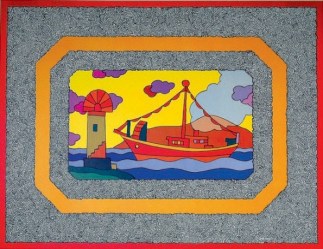Akrithakis Alexis
Alexis Akrithakis was born in 1939, in Athens. Ever since childhood and adolescence, his unconventional personality begins to affect his life. Most schools expel him, labeling him a ‘dangerous troublemaker’. He frequents artistic circles of bohemian intellectuals, while, poet and philosopher, Giorgos Makris and writer, Kostas Tachtsis, become his major influences. In 1958, he travels to Paris on a motorcycle, where he is associated with artists and lives the intense, disorderly life of the post-war existentialism era. He also becomes a close friend of painter Thanos Tsingos, and starts painting on a regular basis. He returns to Greece in 1960, he is exempted from military service and exhibits his early works in Thessaloniki (Veltsos gallery, 1963). Shortly afterwards, his first major solo exhibition is presented at the Athens French Institute (1965). He illustrates Nanos Valaoritis’ innovative literary journal, Pali, designs rock music album covers and stage sets for experimental performances. His black and white drawing technique, tsiki-tsiki, dense, lacelike and labyrinthine, becomes a distinctive feature of his artwork, during the specific period.
In 1968, he settles in Berlin, funded by a DAAD scholarship. From 1970 onwards, he collaborates with gallerist, Alexander Iolas, travels back and forth between Germany and Greece, while he is actively involved in the greek and international art scene, with great success. His provocative and even extreme, at times, lifestyle is integrated in his artistic identity. His artwork is continuously enriched with a multitude of narrative, poetic and symbolic motifs in lively spot colours (i.e. birds, boats, hearts, airplanes, arrows and his emblematic suitcase), as well as collages or mixed media and wooden constructions. Additionally, he creates illustrations and designs objects and theatre stage sets.
He returns to Greece permanently in 1984. By then, he is well established internationally, but his health is poor. He creates the Circus series (1986) in collaboration with the sculptor George Lappas and his painting becomes somewhat gloomier and more sarcastic, without losing its inherent lyricism. His death (1994, Athens) left the last section of his work incomplete: a series of drawings, inspired by his inmates in Dromokaitio psychiatric hospital. Retrospective exhibitions of his work were organized in 1997 (Museum of Contemporary Art, Thessaloniki and National Gallery, Athens) and in 2003 (Neue National Galerie, Berlin). His monograph was published in 2005.
